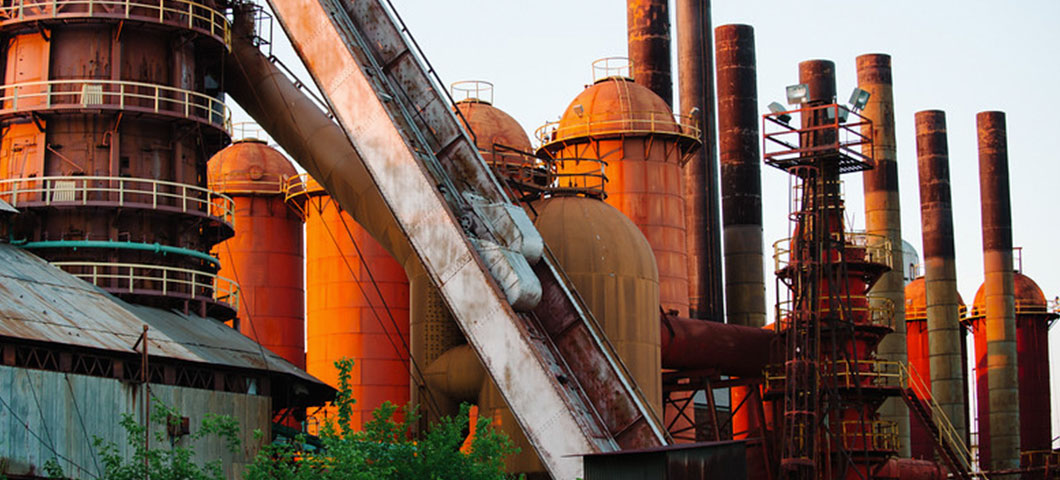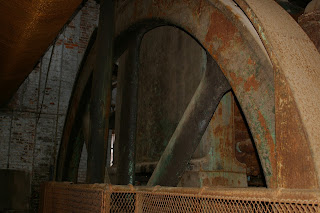Richard came for a visit--part 1
SLOSS FURNACES
It was so fun to have him come! And we had saved visiting Sloss Furnaces to go with him. (picture courtesy of http://www.slossfurnaces.com/)

I learned that day (again) of the sacrifice of so many who "built" this country. The "greatest generation" were not great just because they went to war.........I will try to give you a "picture". Just a warning--- this is a big place and these are "big" people ........almost larger than life...........
They began building Sloss furnaces in 1881, just when the South was beginning to recover from the war. In April 1882 the furnaces "went into blast"--(cool phrase). And once "in blast" they had to stay "in blast" because there would be no way to melt the iron if it cooled inside the furnace. In the first year they produced 24,000 TONS of iron........pig iron......so called because of the way it was formed--looking like a sow suckling her piglets--heavy piglets though, each weighing about 40 pounds.
Every thing seemed oversized........Paul Bunyan size...........above is half a fly wheel used to power the blowing machines to blow the hot air into the furnace. Below--a wrench........
Most of the buildings, pipes, boilers, etc........most of what
you see........is just to create enough hot air--some 1800 degrees F., I
believe--to blast into the bottom of the furnace to burn the coke hot
enough to melt the iron out of the ore. (Very elementary explanation and
terms, but I'm kind of elementary myself). Maybe you can sense I was
fascinated.............and awed.........
Below is the bottom of the furnace. The upper "hole" is called a tuyere (pronounced tweer) It delivers the hot air from the "stoves" into the furnace. The lower hole is where the molten iron would come out. No one was there to explain things, but I assume the iron would then run down the cement trough into the wet sand of the "casting floor" (behind us) that had been molded to make the "pigs". Everything sloped gently "downhill" from the furnace in this direction.
A borrowed picture...........a casting floor from a furnace somewhere else.
https://en.wikipedia.org/wiki/Pig_iron
Now, here's an explanation that says it all....... "The men who broke up and carried out the iron from the sand casting beds were called iron carriers. Edward Uehling, inventor of the mechanical pig casting machine, described their work this way: "When the iron had cooled down to the temperature of solidification, but was still red hot, the iron carriers began their task. They covered the pigs with a layer of sand, then put on shoes with thick wooden soles, walked on the hot iron, and with crowbars broke the pigs off the sow and with sledge hammers broke the sow into pieces the length of the pigs. This was as hot a job as a man could stand, but it had to be done. If the pigs were allowed to get cold, it would not only be more difficult to break the pigs off the sow and the sow into pieces, but the iron could not be carried away in time to mold up [the sand] for the next cast. ...Only one man in ten is physically fit to be an iron carrier, and the best of them cannot stand up under the strain for many years.... The task of breaking up and carrying out the iron from the casting beds of even a modest-size furnace is not a fit one for human beings. If it were possible to employ horses, mules, or oxen to do this work, the Society for the Prevention of Cruelty to Dumb Animals would have interfered long ago, and rightly so."
There was no explanation of
how they carried it out--still scorching hot. And yet they did it!
Between 1927 and 1931 they mechanized the charging--kind of (more later)--and the casting. The man who wrote the explanation above invented a way to pour the molten iron into a metal "pig" mold--no sow--on kind of a conveyor. No more sand molding. I don't know how to explain in words, but thankfully, the "iron carriers" were displaced. I hope they were given an "easier" job somewhere else in the whole process.


The tunnel where the raw materials were measured and then taken to the top of the furnace. The coke or coal (I'm still not clear on that score), iron ore and limestone were brought in on trains above the tunnel--a smoky, dirty place where they loaded wheelbarrows until it was mechanized, put them on an elevator then taken across a "bridge" to the top of the furnace and hand-dumped into the furnace! There were toxic gases up there! The furnace was built to trap those gases and then used them to fire the boilers to create the steam to turn the blowers to move the air through the stoves and to the furnace........incredible process!!! Back to charging the furnace............on either side of the light in the above picture you can see what looks like boxes on the ceiling--they are chutes where the materials came into the tunnel.

The "door" was excessively short...... And the picture below--the marvelous mechanical way to charge the furnace! RAH!! So no men would have to be at the top to dump the wheelbarrows! Though they still had to be below to fill the conveyor........again, I hope no one lost a job, but were able to do something less dangerous and less strenuous.
I'm sure it as a very "rough" workplace, but I have to admire those who were willing to do such work. As a whole, they were good, hard working men with families to feed and educate. We owe them more than we have "given"........ I have to ask myself,
"what legacy am I leaving for those coming 100 years from now."
P.S. I have dozens of pictures............ if you want more, let me know.............



























